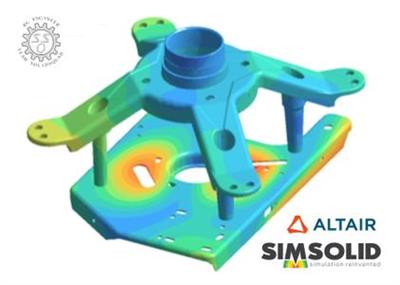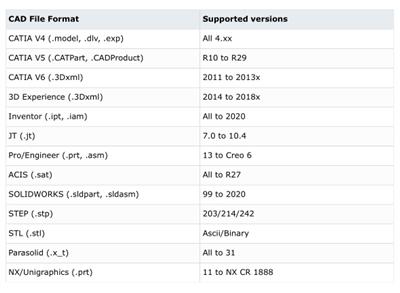Altair announces most significant software update release in company history. Altair SimSolid 2020.0 - includes advanced 3D seam weld connections to further improve speed.
Altair SimSolid 2020.0.0.78 | 516.8 mb
All of Altair's software products have been updated with advancements in user experience and countless new features, including intuitive workflows that empower users to streamline product development, allowing customers to get to market faster.
The software update release expands on the number of solutions available for designers, engineers, data analysts, IT and HPC professionals, facility managers, and more to drive better decisions and accelerate the pace of innovation. It broadens the scope of the new user experience, enables access to more physics, data analytics, and machine learning, and makes the Altair software delivery method more flexible and accessible.
Highlights of this release include new SimSolid Basic product package, 3D solids seam welds, joints connectors, liquid bodies and distributed mass. Several new static and dynamic result types are available. Updated CAD file readers are provided including an all new reader for the JT file format. In addition, many minor usability improvements have been made. See the feature descriptions below for more details.
New Features
SimSolid Basic product package
New from Altair in 2020 is Altair Units, a unified licensing system that gives access to every Altair product in varying capability product bundles. To support this, a new product, SimSolid Basic, in now offered in the Mechanical Designer product bundle. SimSolid Basic provides all modeling functions but is limited to linear statics and modal analysis only.
3D solid seam welds
Seam welds are now modeled as 3D solids. This replaces the previous connection based approach. Welds are defined by section size and length along the edge. Simple trapezoidal shapes are used to represent the welds. Weld material properties are taken from the adjacent parts.
Rotating-sliding hinge
A new remote support is now available. It allows rotation and sliding along a hinge axis between 1 or more faces and ground. This is found as a third option in the virtual connectors Remote support dialog.
Joints
A new set of joint virtual connectors are now available. Virtual joints can be used to connect faces/spots that can have relative motion in the form of displacements and/or rotations. The following joints types are available:
- Ball - A ball joint allows free rotations in any direction about the joint center, while the translations are fully constrained.
- Hinge - A hinge joint only allows rotations about the joint axis. The axis is defined by the joint center and a vector.
- Cylinder - A cylindrical joint allows rotations about the joint axis and sliding along the axis. The axis is defined by the joint center and a vector.
- Linear guide - A linear guide joint only allows sliding along the joint axis. The axis is defined by the joint center and a vector.
- Universal - A universal joint allows rotary motion transmission in multiple shafts which are at an angle to each other. The joint works by allowing free rotations along two mutually perpendicular axis while constraining the rotations about the axis. This joint also constraints all the translations. This joint requires definition of a joint center and axis of the both the shafts connected.
- Flexible shaft - A flexible shaft joint allows complete rotary motion transmission between the two shafts. The joint works by constraining the rotations about the shaft axes. This joint requires definition of flexible-shaft end coordinates and respective shaft axes.
Note: Virtual joints create perfectly rigid boundaries, stresses along the boundary faces can have local concentrations. It is recommended to create joints between parts locally using spots.
Liquid bodies
A new virtual part that represents fluid mass. Adds distributed mass to the structure and, therefore, changes its inertia and dynamics. Mass is determined by the specified fluid density and volume found between the selected faces. The selected faces will represent the wetted surfaces that are in contact with the liquid. The liquid is assumed to be inviscid and incompressible. Sloshing effects are not considered.
Distributed mass
A new distributed mass boundary condition is now available for static and dynamic analysis.
Dynamic results
New velocity, acceleration and equivalent radiated power (ERP) results available for frequency response analysis.
Mode shape export
Mode shapes can now be exported in Universal file (UNV) formatat a given set of datum points using the Pick Info dialog. Datum points can be read in from external comma separated value (CSV) file.
Enhancements/Performance improvements
Harmonic function
Inputs for creating harmonic functions in frequency and random response is now contain amplitude, phase and period.
Static animation
New in frequency response analysis, deformed shape and static animation of displacement, velocity, and acceleration results is now available for each frequency. New selection by face option. This provides an average of the result value over the selected face. In addition to average values, the total thermal flux and total equivalent radiated power (ERP) are provided
Spots on cylinder
Spots in the shape of a circular ring of a specified width on a cylindrical face can now be created. Rig spots can be created on inner or outer cylindrical faces.
Import spots from CSV
Circular spots of a specified diameter can now be createdfrom a list of XYZ locations which are read from an external comma separated values (CSV) file.
New JT CAD reader
A new JT CAD reader is now available. Performance and robustness have been significantly improved.
Updated CAD import formats
The list of supported CAD formats has been updated. JT file support has been extended to release 10.4. Other updates include SOLIDWORKS 2020, Inventor 2020 and NX CR version 1888. The complete list of supported formats and versins is as follows:
Assembly info
More information is provided with respect to CAD settings used andgeometry import/connection search time.
Periodic function
Dynamic functions can now be set to periodic in time/frequency/PSD function dialog.
Export spot weld reaction forces.
Spot weld forces can now be exported in global system.
Info on Spots, spot welds and rivets expanded
The Info dialogs for Spots, spot welds and rivetsnow contain more information such as connected parts names.
Resolved Issues
- Fixed - The Cancel button on connection search and analysis progress is now more responsive.
- Fixed - issues with displacement as base excitation.
- Fixed - numerical issues with inertia relief.
- Fixed - numerical issues with remote mass.
- Fixed - a number of issues with spot weld creation.
- Fixed - issues related to adapt for thin solids especially on wired structures.
- Fixed - Issues with bonded contact in geometric nonlinear analysis.
- Removed - cylindrical coordinate system from general constraints in modes
Altair SimSolid is structural analysis software developed specifically for rapidly evolving design processes. It works directly on CAD geometry and eliminates geometry simplification and meshing, the two most time consuming and expertise extensive tasks done in traditional FEA. Moreover, SimSolid can analyze complex parts and large assemblies not practical with traditional FEA and do it efficiently on a desktop class computer. Both fast and accurate, SIMSOLID controls solution accuracy using a unique multi-pass adaptive analysis.
Join the Simulation Revolution with Altair SimSolid - No Meshing Required
Altair transforms design and decision making by applying simulation, machine learning and optimization throughout product lifecycles. Our broad portfolio of simulation technology and patented units-based software licensing model enable Simulation-Driven Innovation for our customers. With more than 2,000 employees, Altair is headquartered in Troy, Michigan, USA and operates 71 offices throughout 24 countries. Altair serves more than 5,000 customers across broad industry segments.
Product: Altair SimSolid
Version: 2020.0.0 Build 78
Supported Architectures: x64
Website Home Page :Language: englishKod:http://www.altair.com]www.altair.com
System Requirements: PC *
Supported Operating Systems: *
Size: 516.8 mb
Platform support and system requirements
The recommended computer configuration is an Intel I7 or I9 or Xeon based computer; 4-cores (8-threads); 16 GB of memory; OpenGL compatible graphics card with OpenGL 3.1 or later; running Microsoft Windows 10 (64-bit only). SimSolid is multi-threaded so more cores are always better. To use the direct document integration to Onshape, you must have either a free or paid Onshape account. There will be a one-time prompt to authorize SimSolid to access your Onshape account. To use the SOLIDWORKS add-in, you must have a 2013 through 2020 version of SOLIDWORKS.
Download link:Kod:rapidgator_net: https://rapidgator.net/file/34d3e2503aff7c3d738b3da648b95a23/s1t39.Altair.SimSolid.2020.0.0.78.rar.html nitroflare_com: https://nitroflare.com/view/74A9FD7AEF273FB/s1t39.Altair.SimSolid.2020.0.0.78.rarLinks are Interchangeable - No Password - Single Extraction
1 sonuçtan 1 ile 1 arası
-
01.07.2020 #1Üye



- Üyelik tarihi
- 20.08.2016
- Mesajlar
- 144.971
- Konular
- 0
- Bölümü
- Bilgisayar
- Cinsiyet
- Kadın
- Tecrübe Puanı
- 153
Altair SimSolid 2020.0.0.78
Konu Bilgileri
Users Browsing this Thread
Şu an 1 kullanıcı var. (0 üye ve 1 konuk)



 LinkBack URL
LinkBack URL About LinkBacks
About LinkBacks






 Alıntı
Alıntı
Konuyu Favori Sayfanıza Ekleyin